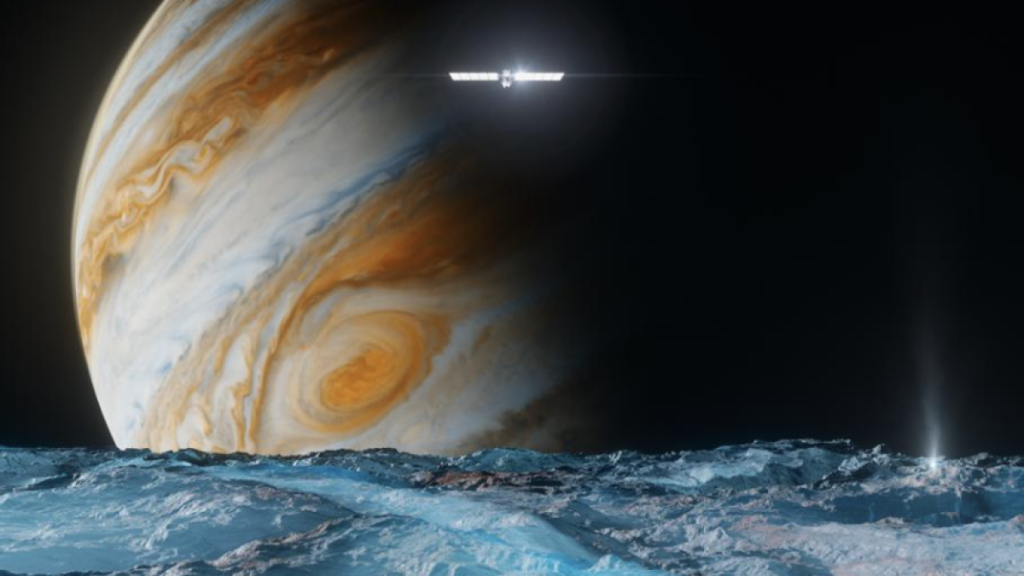The brains of NASA’s Europa Clipper spacecraft are stored in a metal vault.
It’s where the large exploration vehicle — the length of a basketball court — safeguards its computers, software, and many electronics. The craft is about to launch to Jupiter’s moon Europa, a world planetary scientists suspect harbors an ocean twice the volume of Earth’s. With around 50 close swoops by Europa, NASA will be able to confidently answer the question of whether this ocean realm also hosts the ingredients, such as an energy source and telltale materials, to support life.
Yet the radiation environs there are particularly harsh.
“The charged particle environment at Europa’s location is immense,” Cynthia Phillips, a NASA planetary geologist and project staff scientist for the space agency’s Europa Clipper mission, told Mashable.
Jupiter, a gas giant planet 317 times more massive than Earth, generates a massive magnetic field shooting out between 600,000 to 2 million miles (1 to 3 million kilometers) toward the sun. It’s created by the planet’s liquid metal core, which spins and creates electrical currents (moving electric charges make magnetic fields). Crucially, this magnetic field grabs and then accelerates particles from the relentless solar wind — a stream of rapidly traveling charged particles emitted by the sun — which creates potent radiation belts around Jupiter.
“It bombards everything.”
Any craft traveling around the planet will almost certainly pass through these hazardous zones and expose instruments to harmful particles, which can damage computer chips and electronics. “It bombards everything,” Curt Niebur, Europa Clipper’s program scientist, said at a press conference leading up to the mission’s launch. Decades ago, during the Voyager mission, NASA’s engineers were worried about the craft passing by Jupiter. A person hypothetically riding aboard Voyager as it passed Jupiter would have gotten hit with a radiation dose 1,000 times the lethal level.

A depiction of Jupiter’s sprawling magnetic field. If was visible to the naked eye, “it would appear two to three times the size of the sun or moon to viewers on Earth,” NASA explained.
Credit: NASA Goddard Space Flight Center

“The relative intensity of Jupiter’s radiation bands is illustrated in this diagram,” NASA explains, with darker reds depicting more radiation. Both Europa and Europa Clipper’s orbits are depicted in the graphic.
Credit: NASA
Hence, the vault. “The vault seriously reduces the harmful radiation these electronics get,” Phillips said. (NASA’s Juno craft, exploring the greater Jupiter system, also carries a vault.)
Mashable Light Speed
Yet there are electronics outside this protective metallic box. And in May NASA received test data that suggested some transistors — which are electrical switches that control how electricity flows around the spacecraft — couldn’t withstand the high radiation environs around Europa. Fortunately, intensive follow-up testing showed these switches will work as the craft makes some 50 flybys over three and a half years. “They unequivocally passed that review today,” Nicola Fox, who heads NASA’s Science Mission Directorate, said following a pivotal September decision to green-light the mission.
But mission engineers will be watching these transistors closely. As the New York Times reported, NASA bolted a late add-on to the craft, a small “canary box” holding the different types of transistors. If any show signs of damage or dysfunction as Europa Clipper swoops through belts of radiation, planners could adapt the mission.

In this graphic, the box illuminated in red shows the Europa Clipper’s vault on the center of the spacecraft.
Credit: NASA

An artist’s conception of the ocean, and geothermal energy sources, that could exist beneath Europa’s thick ice crust.
Credit: NASA
Already, the mission’s orbital plan — which is to zip away from damaging regions after making close flybys of the ice-covered moon — minimizes the time the craft is exposed to high radiation zones. During each orbit around Jupiter, the craft will spend under a day in an irradiated zone, before swooping out. It won’t return for between two to three weeks.
“You get out of there,” Phillips told Mashable.
“You get out of there.”
The robotic spacecraft’s exposure to radiation, however, comes with rewards. When the probe dips close to Europa between 2031 and 2034, it will have the chance to view, scan, and investigate Europa in unprecedented detail. A ground-penetrating radar will look under the ice, and potentially see areas of liquid water or even where the ice meets the alien ocean. An instrument called the SUrface Dust Analyzer, or SUDA, will literally sample particles of Europa that have been ejected into space by tiny meteorites. And, of course, Europa Clipper will capture a bounty of images.
“The images are going to be spectacular,” said Laurie Leshin, director of NASA’s Jet Propulsion Laboratory, the agency center that built the craft.
In sum, with this orbiting laboratory of instruments, NASA will be able to determine if the ocean moon has the right stuff — energy sources, a long-lived stable ocean, organic compounds (like carbon) — for life. If so, the agency plans to return to Europa and land on the icy crust. This time, they won’t just be looking to see if it’s habitable. They’ll drill into the ice, looking to see if it’s inhabited.
“We’ll be knocking on the door for a second mission,” Niebur said.


